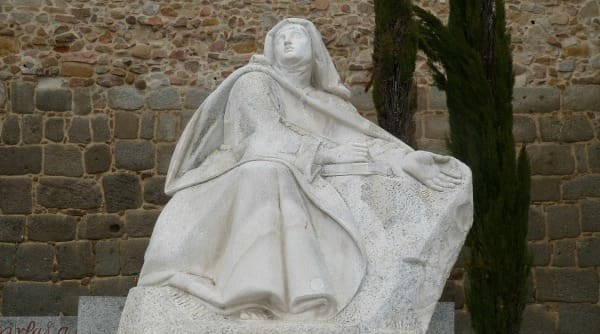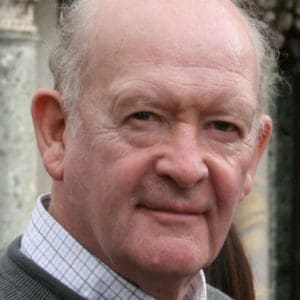Editor’s note: David Torkington continues his series on prayer with the fourth and final section, “From Meditation to Contemplation”. Read part 42 here, and begin with part one here.
The Mystic Way Part IV
The new, sudden and dramatic experiences that had all but overwhelmed me in my prayer life needed an explanation. Deep down I knew I was experiencing God’s love enveloping me, but I still needed some sort of assurance that I was on the right road. I discovered that like St. John of the Cross, St. Teresa of Avila was a Doctor of the Church and while he excelled in describing mystical darkness, she excelled in describing mystical light in her masterwork, Interior Castle. I had been staggered to discover how St. John of the Cross understood the darkness through which my inner soul had been traveling. This time I was staggered to discover how St. Teresa of Avila understood the experiences of light that had raised me up above myself to experience something of God’s love reaching out to touch me.
Seeking Reassurance
However, I still felt the need to express myself to a living human being who could reassure me too. St. Teresa of Avila had said that she would rather seek advice from a learned man than from a pious one, so I approached the most learned man in the Province who taught us Theology. While assuring me that my experiences were genuine, Fr. Gabriel also insisted that he had never experienced them himself. When I protested that I was no better than the other students, and no more virtuous than my peers, he answered that such graces that I had received were not given as a reward for my virtuous life, but to give me the grace to live a virtuous life in the future.
I came away feeling chastened as the words of the Gospel came into my mind. ‘To whom much is given, much will be required’. For the first time in my life, I was totally and transparently honest when I expressed my unworthiness. True humility comes, not from being humiliated for a year by a novice master, but from the experience of He who is mighty doing great things in you and realizing that you are totally unworthy of it. My experience in the Swiss Alps was right after all.
St. Teresa Bares Her Soul
If I was in danger of becoming arrogant at the thought that God had singled me out for these mystical graces, then I would have to have to think again, when in little less than a month they were taken away from me and I was left back where I started for several years. The purification went on whether I liked it or not, but now I had the assurance that I was on the right way, and the way ahead was the deep mystical purification towards union with the only One who would lead and guide me along that way. The way ahead for the saints took many years, but for me would take many decades. The sort of experiences that I had, come and go in such a way that the receiver is left in no doubt who is in control of their spiritual purification that takes place sometimes in darkness, sometimes in light.
Later I will explain the psychological reasons why one follows the other in this way. However, I have no intention of detailing any further my spiritual journey because it is private and personal. I have only described what happens at the beginning for the same reason that St. Teresa wrote her Interior Castle. She bared her soul far more completely than I intend to do. And then it was only for her sisters in Carmel, for fear they should be misled by the sort of ignorant spiritual directors whom she said she had to endure.
The Way Ahead in the Mystic Way
St. Teresa calls the first gentle feeling of God’s love as the Prayer of Recollection and the far more powerful experience of his love that follows, as The Prayer of Quiet. For St. Teresa this is the first stage of experiential mystical contemplation, and it is a pure gift of God as the recipient soon realizes, as it comes and goes without anything we can do to generate or prolong it.
In both the Prayer of Recollection and the Prayer of Quiet there are distractions and temptations that are always there beneath the surface. Their strength depends on the power of the mystical experience. In the Prayer of Quiet for instance, sometimes the experience is fairly weak but sometimes there is a lifting sensation in the head and the receiver is raised to experience this prayer to a higher degree of consciousness. Although there are always temptations and distractions beneath the surface, their strength becomes weaker and weaker as the mystical experience becomes stronger and stronger.
However, when a person is taken up into the Prayer of Full Union the experience is so powerful that for the first time there are no distractions of any kind to interrupt. The intensity of the power that captivates is so utterly enthralling and captivating that the receiver cannot move from the spot where they are praying, or at least not without a great effort. Unlike the Prayer of Quiet, this prayer only lasts for a brief time – ten to twenty minutes, before it subsides, leaving a person back in The Prayer of Quiet.
As the high point of The Prayer of Quiet, Full Union begins with a lifting sensation, but this sensation not only becomes far more powerful but begins to spiral upwards at great speed. The receiver is seized with a fear that the power of this experience might be too much for them and they might be taken out of themselves into some sort of ecstasy. This fear is not without foundation because this can, and sometimes does, happen when the power of God’s love becomes so great that ecstasy does take place, to the dismay of the receiver. This experience is not just a faint because the person who experiences it remains exactly how they were. They do not fall to the ground but remain standing, sitting, or kneeling, totally lost in God until he withdraws the power of love that was enthralling them in such a dramatic way.
The Ecstasies of St. Philip Neri
St. Philip Neri, who was often swept up into an ecstasy, did not so much see it as a grace but as an embarrassment and he continually prayed to God to relieve him of the ‘privilege’. He would be mortified when he was taken up into an ecstasy at Mass which was a regular occurrence, or even when preaching or walking down the street. All these mystical experiences are not in essence completely different but the same experience of God’s Love, but with ever-mounting power and magnitude and therefore with a corresponding effect on the receiver. Imagine them if you like as a color – the color yellow. Initially, this color is so pale that it can hardly be distinguished from white, but then it can become ever-deeper and richer until it becomes a deeply rich and dazzling gold. As different names are given to the different degrees of intensity of the color, the same happens to different degrees of intensity with which the love of God is experienced in the mystic way.
All these experiences take place in the higher part of the head, but for a Christian, this is not the summit of the mystic way because the Holy Spirit has been sent not just to purify and penetrate our head but our whole human being. This is so that we can come to be transformed and transfigured as the body of Jesus was transformed before Peter, James, and John. The Transfiguration on Mount Tabor was a pre-enactment of what would happen to Jesus after the Resurrection when he was glorified. The event not only pre-enacts what happened to Christ at his glorification but what will happen to us too when the Holy Spirit penetrates us as Jesus was penetrated by the glory of God.
Mystical Marriage or the Transforming Union
When this purification is complete, the Holy Spirit can pour his love into us to penetrate and possess the whole person, mind and heart, body and spirit, in what is called the Mystical Marriage or the Transforming Union. This takes place, as the preceding experiences of light and darkness, in the Mystical Body of Christ, finally enabling a person to participate more fully than ever before in Christ’s mystical contemplation of his Father. While all previous experiences would come and go, including what St. Teresa calls the Spiritual Betrothals, the Mystical Marriage becomes permanent, enabling the recipient to be aware of their continual union with Christ at all times.
As would be expected, the Spiritual Betrothals precede the Mystical Marriage but unlike secular betrothals, they can take place many years, even decades before the marriage itself. Many more people experience the Spiritual Betrothals in this life than go on to enjoy the Mystical Marriage before they die. The Spiritual Betrothals usually begin while a person is experiencing the Prayer of Quiet and are characterized by a tingling feeling in the body that is usually triggered by a sudden spiritual thought or realization. This may come from a scriptural text that strikes you like never before or the realization of what gifts God is giving you and the counter realization of your total unworthiness. However, I would like to make it clear that this does not happen at the beginning, but towards the very end of the Dark Night of the Spirit and after very many years if not decades of penetrating purification.
The Spiritual Re-Sensitization of the Body
This is the beginning of the spiritual re-sensitization of the body and the reopening of the feelings and the emotions that have been rendered inactive and unresponsive during the long Dark Night of the Soul. It is for this reason that St. Teresa said first fervor is, in a sense, a premonition of the Mystical Marriage.
There is one thing above all else that grows, even in the darkest moments of purification, and that is the understanding and appreciation of the faith and how God wishes us to implement it, giving us the power to do it. The continual contemplation that Christ experienced while he was on earth enabled him to see the truth that God wanted him to proclaim with ever-increasing understanding (Luke 2:52), and to proclaim it despite knowing the consequences. What was true for Christ would be true for all who follow him. The suffering of purification inside of prayer is always compounded by the suffering experienced outside of prayer by those who try to proclaim the same truth for which their Lord was crucified. That is why St. Paul said that he preached Christ and Christ Crucified, and was ‘crucified’ for doing it.
David Torkington is the author of Wisdom from the Western Isles and Wisdom from the Christian Mystics which complement this series.
Image used with permission of Pixabay.





